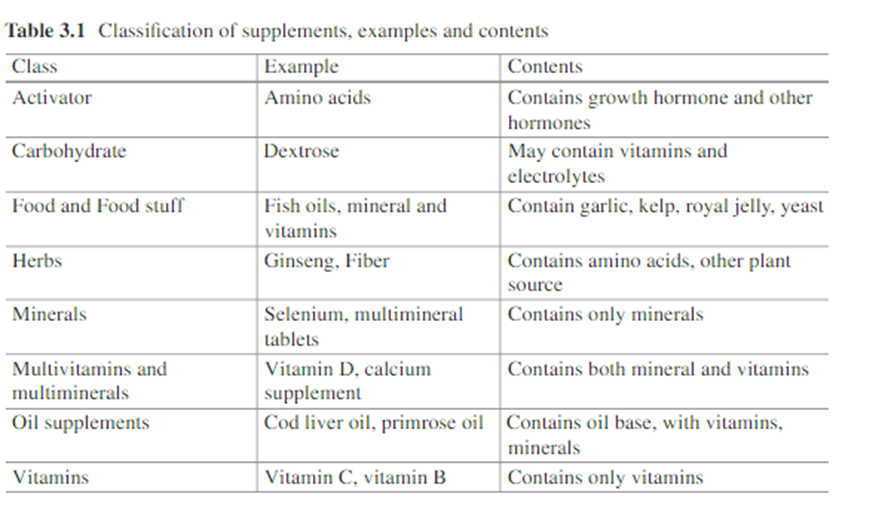The diet is now regarded as much more prosperous than it used to be. People’s ignorance of basic nutritional principles has led to a huge portion of the population eating a diet high in calories and fat but poor in proteins, vitamins, and minerals (Kourkouta et al. 2016). Because of this long-term scenario, different degenerative diseases have emerged. Dietary supplements and nutritional supplements were recommended as a solution to this problem to address this concern.
Dietary supplements are items that contain one or more concentrated nutrients. They are intended to supplement an individual’s daily diet when it is unbalanced or lacking in nutrients. Dietary supplements are not common foods, medicines, or special dietary items and are not meant for specific groups of people (www.nutrinews.gr). Supplements provide the body with the necessary components to maintain good physical and mental health.
As a result, the human system would not be fatigued, and injuries and exhaustion would be avoided (Kourkouta et al. 2016). Dietary supplement manufacture and consumption have both expanded significantly in the recent decade. The majority of these supplements are available in tablet or powder form. Although increasing consumption is expected to provide health benefits, excessive consumption may result in larger levels of vitamins and minerals that the body cannot tolerate.
As a result, over usage of dietary supplements exposes consumers to health hazards. The situation gets more serious when consumers use these supplements without a prescription or under medical supervision (Beitz et al. 2004).

Balanced Diet and Dietary Supplements
Any vitamin, mineral, chemical substance, herbal product, botanicals, amino acids, or other ingestible preparation that is added to the diet to benefit human health is referred to as a dietary supplement. Dietary supplements are utilized worldwide and are a vast group of ingestible goods that can be distinguished from regular foods and pharmaceuticals (Watson et al. 2010; Berginc and Kreft 2014).
Nutrition is well known to significantly affect health. However, most people are aware of a key question that everyone nowadays asks: “Will a conventional and balanced diet without supplements be able to cover all of the needs of the human body for a healthy lifestyle until old age?”
For years, nutritionists and health professionals maintained that people could acquire the most important food requirements for their bodies each day from a normal, balanced, and consistent daily diet. Dietary guidelines issued by health and nutrition organizations worldwide cover more than 40 nutrients, which are classified into six categories: carbs, lipids, proteins, vitamins, minerals, and water.
Dietary reference intakes (DRIs) refer to daily nutrient recommendations. A healthy diet emphasizes “real” fresh whole foods that have sustained people for millennia. Whole foods provide the vitamins, minerals, protein, carbohydrates, fats, and fiber required for optimal health. A well-balanced diet includes foods from all food groups (vegetables, legumes, fruits, grains, protein foods, meat, and dairy).
Eating various meals from all food groups helps ensure you get all of the nutrients you need for a healthy diet. The Mediterranean diet’s components are significantly beneficial to human health (Katz and Meller 2014; Widmer et al. 2015).
The World Health Organisation (WHO) recommends the following for a balanced and healthy diet: (a) eat roughly the same amount of calories as your body uses, (b) a healthy weight is a balance between energy consumed and energy that is ‘burned off,’ (c) limit intake of fats, preferring unsaturated fats over saturated fats and trans fats, (d) increase consumption of plant foods, particularly fruits, vegetables, legumes, whole grains, and nuts, (e) In contrast, many commercially produced foods, often known as fast foods, lack nutrients and contain excessive levels of sugar, salt, saturated and trans fats, all of which are linked to the development of diseases.
Global Market of Supplements
Nutrition and supplements were worth over $90 billion worldwide. Sales and growth estimates in markets with large nutrition and dietary supplement sectors are intriguing (Nasdaq 2015; CMR 2015). Geriatrics, pregnant women, and urbanization drive the global mineral supplement industry. Baby boomers will increase mineral supplement spending. Calcium, phosphorus, zinc, alkaline pH booster, sodium, potassium, chlorine, sulfur, magnesium, iron, boron, manganese, chromium, copper, iodine, cobalt, fluoride, selenium, colloidal silver, and trace minerals make up the mineral supplement market. The global mineral supplements market was $9.9 million in 2014 and is predicted to rise 7.5% from 2015 to 2020.
Vitamin and poly-vitamin supplements are popular and growing in popularity due to advertising. The global vitamin supplement industry was worth US$37 billion in 2014 and is anticipated to expand by 6.5% yearly from 2014 to 2020. Consumer demand for preventative healthcare drives this. As healthcare costs rise, many resort to vitamin supplements to avoid disease. (https://www.psmarketresearch.com/market-analysis/ vitamin-supplements-market). In 2000, 158 million Americans—more than 50% of the US population—took dietary supplements, including vitamins, according to FDA testimony. 80 million Americans used alternative medical methods and herbal supplements (Kennedy 2005; Wilson et al. 2006).

Supplement Formulations
Depending on how they’re consumed, food supplements come in different sizes and shapes. Tablets, capsules, powders, oral ampoules, effervescent tablets, chocolates, and syrup-based mastics are available. Food supplements can be taken in several ways: (a) oral pills or powders for relatively quick absorption; (b) sublingual drops or oral disintegrated tablets for ease of intake and to limit active substance damage; (c) nose spray or drops to further improve absorption; (d) injectables through intravenous and intramuscular injections for quick absorption and action; and (e) bone-anchored for slow and gradual absorption and prolonged action (American Diabetes Association ADA 2001).
Some supplements are poorly absorbed, some are nearly destroyed by stomach fluids, while others irritate the stomach and intestinal mucosa. Powders and liquids help folks who have trouble swallowing pills. Spray supplements might cause severe irritation or lung aspiration. Doctors always inject vitamins. Bone-anchored supplements must be administered in hospitals due to surgical methods, monitoring, and laboratory control to minimize local inflammations and problems (Teixeira 2013). If a supplement causes a drastic change in urine color, it’s either not absorbed or the dose is too high. This makes us question supplement efficacy and potential danger (Mulholland and Benford, 2007).
Classification of Supplements
The National Agency of Medicines classifies dietary supplements into two groups based on their intended purpose (EUFIC 2009):
(1) Food supplements supplement the diet.
(2) Foodstuffs for specific nutritional uses, such as beverages, are intended for certain population groups, such as healthy infants or children between two and ve, special categories of people with disordered metabolism, or special physiological conditions. Natural and synthetic supplements can be separated. They are grouped by texture or form:
(a) Vitamin and mineral supplements, whether they are multivitamins or multi-minerals,
(b) Protein supplements, liquid or tablet, with or without carbohydrates, fats, vitamins, and minerals,
(c) All amino acids,
(d) Weight-gain supplements,
(e) Powder, wafer, or biscuit meal surrogates,
(f) Carbohydrate supplements with or without electrolytes and vitamins,
(g) Natural anabolic supplements not on the “banned substances list,”
(h) “Activator” supplements of growth hormone and other hormones,
(i) Basic fatty acid supplements,
(j) Foodstuffs or food constituents such yeast, garlic, kelp, royal jelly,
(k) Herbs.
Thousands of supplements exist. Some are nice, some moderate, and some bad. Their low efficiency is due to their manufacturing process and raw materials (Rovira et al. 2013). Table 3.1.S. Hassan et al.


